✨hello,进来的小伙伴们,你们好耶!✨
🍔🍔系列专栏:【数据结构与算法】
🍬🍬本篇内容:LinkedList的模拟实现!
🍯🍯作者简介:一名双非本科大三在读的Java编程小白,星夜漫长,你我同行!
🍩🍩给大家推荐一个超级好用的刷题网站——牛客网!
点击链接注册,开启刷题之路!

目录
LinkedList底层就是一个双向链表,我们来实现一个双向链表。
1、首先定义一个静态内部类
static class ListNode {
public int val;
public ListNode prev;
public ListNode next;
public ListNode(int val) {
this.val = val;
}
}
public ListNode head;
public ListNode tail;
2、打印双向链表
public void display(){//打印双向链表
ListNode cur = this.head;
while (cur!=null){
System.out.print(cur.val+" ");
cur = cur.next;
}
}
头插打印结果:

** 尾插打印结果:**
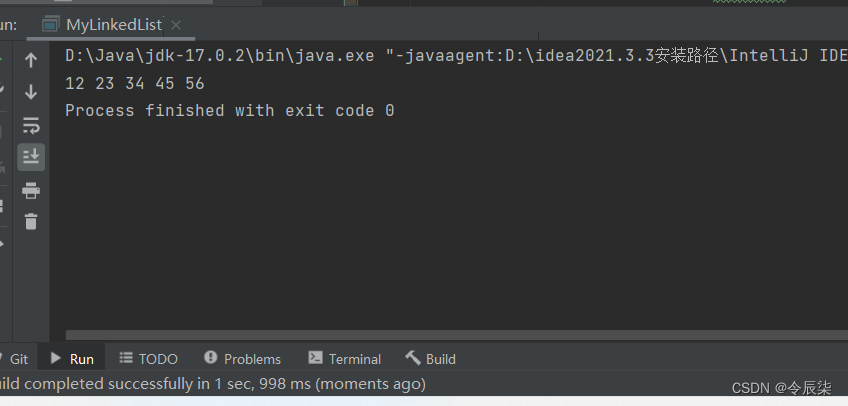
3、获取链表长度
public int size(){//获取链表长度
ListNode cur = this.head;
int count = 0;
while (cur!=null){
count++;
cur = cur.next;
}
return count;
}
运行结果:
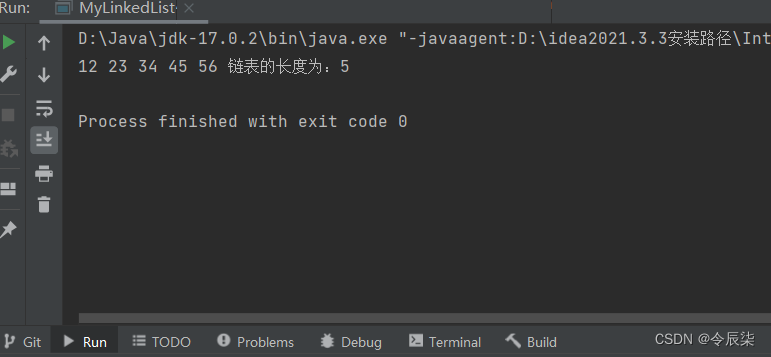
4、判断关键字key是否在链表中
public boolean contains(int key){//判断关键字key是否在该链表中
ListNode cur = this.head;
while (cur!=null){
if(cur.val == key){
return true;
}
}
return false;
}
主函数代码:
public static void main(String[] args) {
MyLinkedList myLinkedList = new MyLinkedList();
myLinkedList.addLast(12);
myLinkedList.addLast(23);
myLinkedList.addLast(34);
myLinkedList.addLast(45);
myLinkedList.addLast(56);
boolean b1 = myLinkedList.contains(12);
System.out.println(b1);
运行结果:
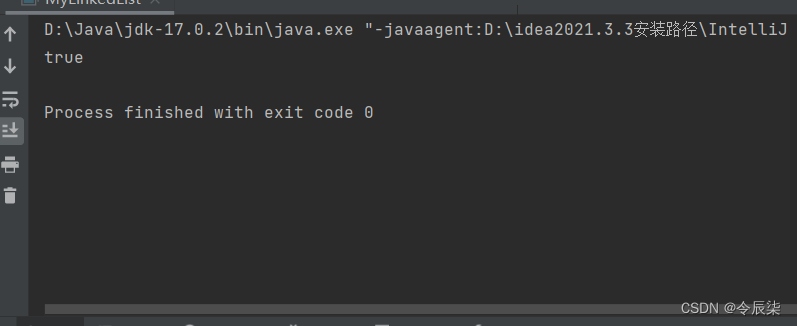
5、头插法
public void addFirst(int data){//头插法
ListNode node = new ListNode(data);
if(this.head == null){
this.head = node;
this.tail = node;
}else{
node.next = this.head;
this.head.prev = node;
head = node;
}
}
6、尾插法
public void addLast(int data){//尾插法
ListNode node = new ListNode(data);
if(this.head == null){
this.head = node;
this.tail = node;
}else{
tail.next = node;
node.prev = tail;
tail = node;
}
}
7、任意位置插入
//任意位置插入,第一个数据节点为0号下标
public void addIndex(int index,int data){
//1、判断Index位置的合法性
//2、判断特殊位置,头插 和 尾插
//3、找到index位置节点的地址
if(index<0 || index >size()){
return;
}
if(index == 0){
addFirst(data);
}
if(index == size()){
addLast(data);
}
ListNode cur = findIndexListNode( index);
ListNode node = new ListNode(data);
node.next = cur;
cur.prev.next = node;
node.prev = cur.prev;
cur.prev = node;
}
private ListNode findIndexListNode(int index) {
ListNode cur = head;
while ((index != 0)) {
cur = cur.next;
index--;
}
return cur;
}
运行结果:(这里我们假如在2位置插入元素888)
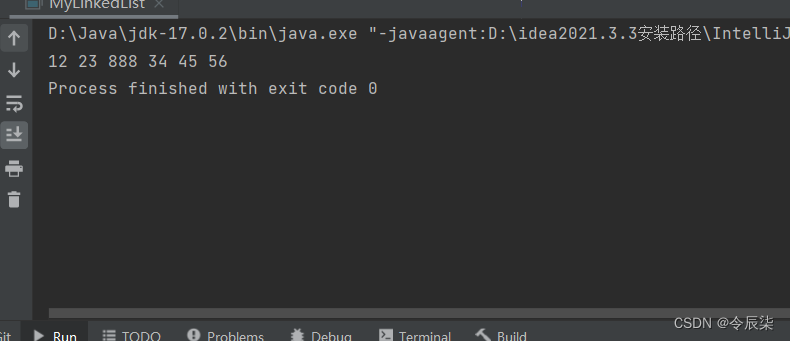
8、删除第一次出现值为key的节点
public void remove(int key){//删除第一次出现关键字为key的节点
ListNode cur = head;
while (cur!=null){
if(cur.val == key){
if(cur==head) {
head = head.next;
if(head!=null){//表示只有一个节点的情况下
head.prev = null;
}else{
tail = null;
}
}else{
cur.prev.next = cur.next;
if(cur.next!=null){
cur.next.prev = cur.prev;
}else{
this.tail = cur.prev;
}
}
return;
}
cur = cur.next;
}
}
运行结果:(假如我们头插四个元素值都为12还有一个元素值为56)
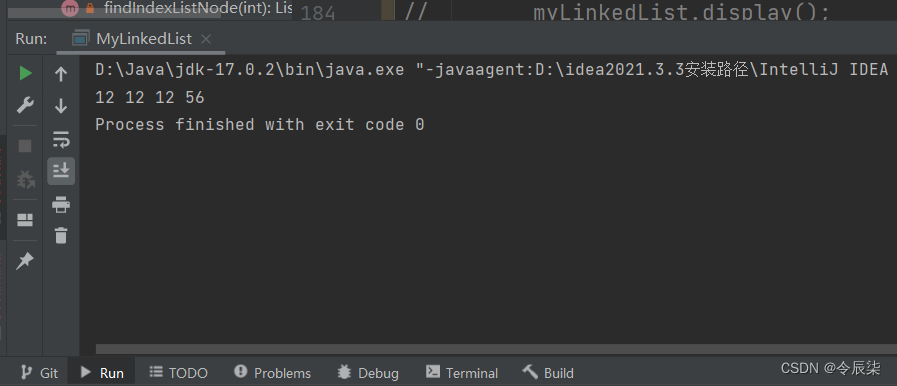
9、删除所有值为key的节点
public void removeAllkey(int key){//删除所有值为key的节点
ListNode cur = head;
while (cur!=null){
if(cur.val == key){
if(cur==head) {
head = head.next;
if(head!=null){//表示只有一个节点的情况下
head.prev = null;
}else{
tail = null;
}
}else{
cur.prev.next = cur.next;
if(cur.next!=null){
cur.next.prev = cur.prev;
}else{
this.tail = cur.prev;
}
}
}
cur = cur.next;
}
}
运行结果:(假如我们头插的元素有五个其中四个都为10 另一个为20)
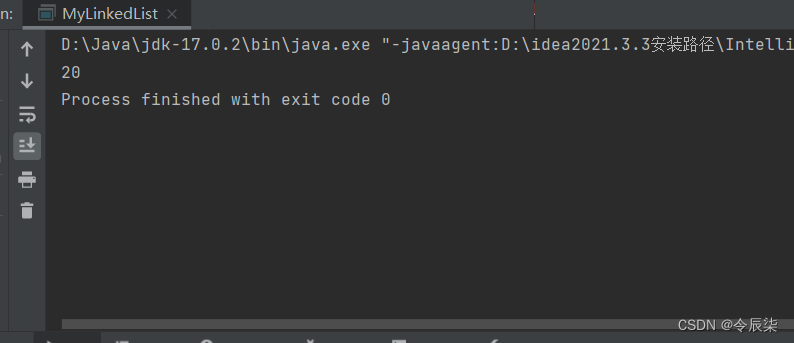
10、置空
public void clear(){//一个一个置空
ListNode cur = head;
ListNode curNext = cur.next;
while(cur!=null){
head.next = null;
head.prev = null;
cur = curNext;
}
}
运行结果:
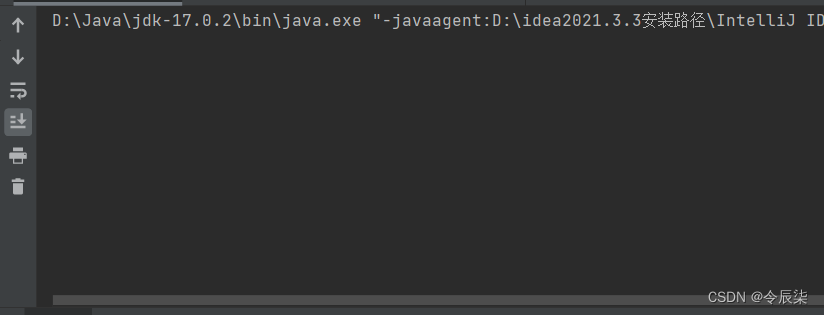
版权归原作者 令辰柒 所有, 如有侵权,请联系我们删除。